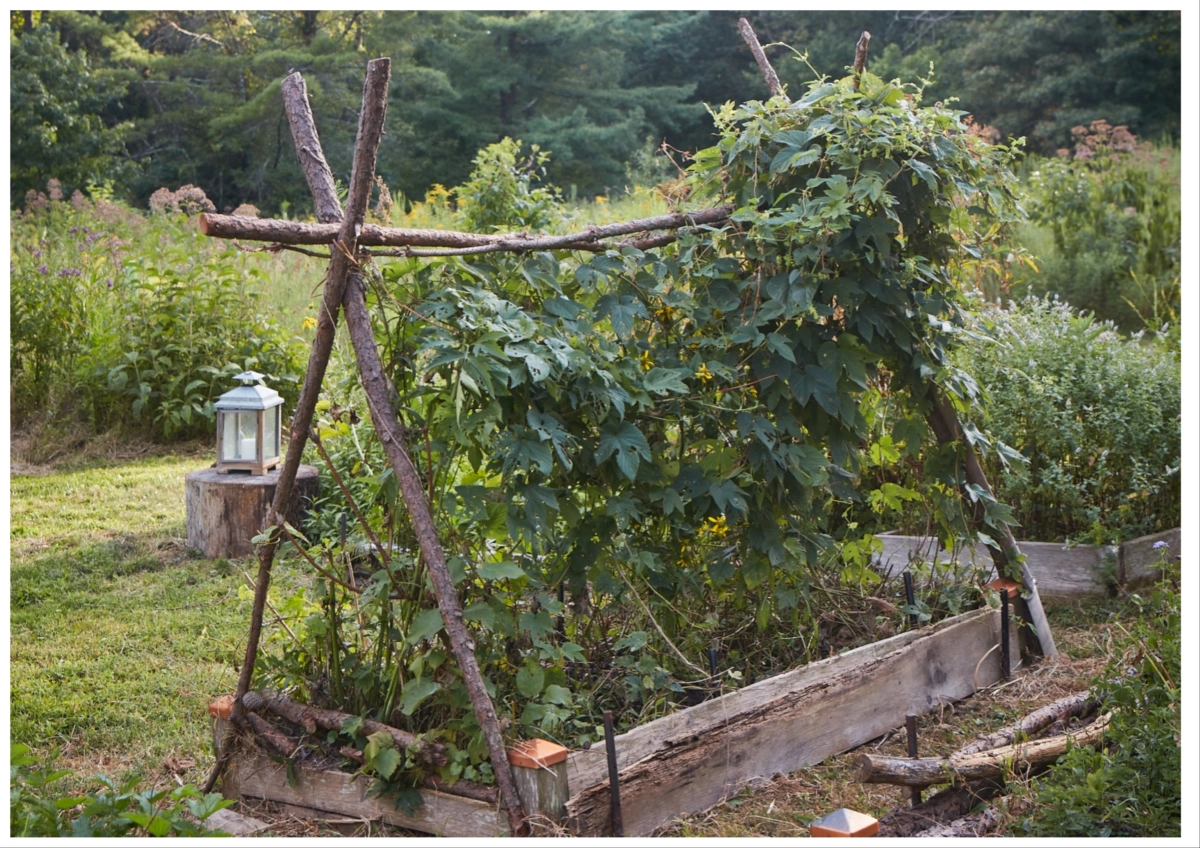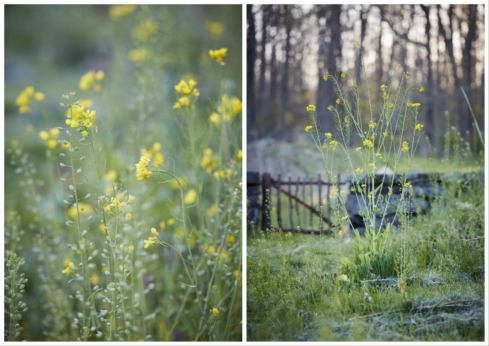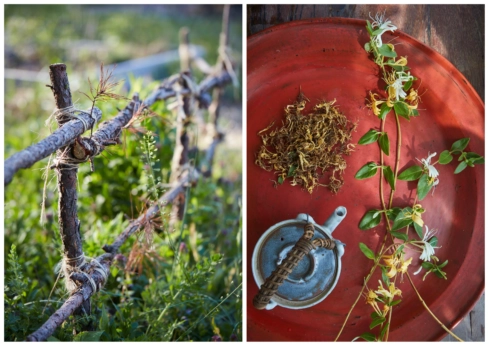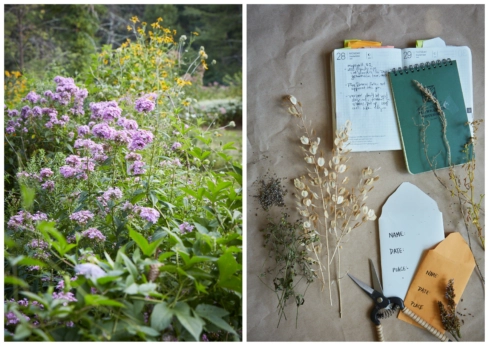Making ‘Weeds’ Part of the Food System
Tama Matsuoka Wong’s new book, Into the Weeds, is an invitation to change the way you look at what grows around you.
Making ‘Weeds’ Part of the Food System
Tama Matsuoka Wong’s new book, Into the Weeds, is an invitation to change the way you look at what grows around you.

Wong's wild garden.by Ngoc Minh Ngo
The summer I was 18, I worked a few hours a week on a small farm just outside of Portland, Oregon. It was a perfect gig for between school terms—I would help harvest things for the farmers market, pick weeds and occasionally round up a turkey that had escaped its enclosure.
Surrounding the immaculate rows of kale that sold well in downtown Portland, some “weeds” would pop up in bunches. My boss told me to pick these plants, called lambsquarters, to make way for the kale, but said that I should feel free to take them home and eat them, as they were actually delicious. I did—there were a lot of nights that summer that I had steamed lambsquarters on top of herby rice and lentils or in a stir fry.
Why couldn’t we bring these into town to sell at the farmers market? It had nothing to do with the taste or nutritional value—lambsquarters are on par with the best of greens. But, simply put, there was no market for these “weeds.” They weren’t trendy like kale, nor did they have an old standby reputation like spinach. And so, even though they grew abundantly without being planted, most of them just went to the compost pile.
Tama Matsuoka Wong’s new book, Into the Weeds, out March 12, resurfaced my memory of lambsquarters with a new curiosity. Not only does she mention them, she lists them as one of the top species to forage. Wong is a professional forager, finding, growing and collecting edible plants, many of which are considered weeds by the general population. She sources many of these plants from her own land—letting plants grow where they prefer instead of in orderly crop rows—and sells them to top restaurants in New York City, pulling them out of the “weed” category and onto dinner plates. After reading her book, which includes experiential knowledge, reflections, how-tos and a handful of recipes, I couldn’t wait to ask her more about her process.
This interview has been edited for length and clarity.
Modern Farmer: There’s a term you use in your book that we should define. What is a “wild garden”?
Tama Matsuoka Wong: You might think that “wild” and “garden” are kind of contradictory to each other. But I mean, a garden in the larger sense of things is really anything that you can tend and enjoy—I think it’s something you relate to. So, a “wild garden” I view as something that is less created and controlled by you, and it has a lot more of its own initiative. I feel like it’s more dictated by the plants and their behavior. I’m not saying 100 percent, but it’s less of a cultivated garden, which is almost all created and planted by a person.

MF: You forage foods such as lemon balm, chickweed and nettle, and your buyers include some very nice restaurants in New York City. What is the significance of creating a market for something that many people perceive as a weed?
TMW: I want [the work that I do] to become part of the food system. And so, in that sense, an easy way to start with that is to start with restaurants. It’s a very interesting creative [research and development] effort to kind of take something that some people might not be familiar with and make it taste delicious, right? Chefs just love that.
That being said, a lot of the plants that I am referring to are culturally significant. And in those countries, they are already culinary. And so, if I bring that to a chef who is from that place, they’re like, “oh my gosh.” To them, it’s just like home sweet home. That’s also what I think is great—people bring it as part of their culture. So, that’s what’s exciting about it.
The big difference is to try and really have these weeds or these plants make [their] way into the actual food system so people become more familiar with it. But it’s also something that eventually is pretty easy, and I think that’s happening. I see it at farmers markets, for sure.
MF: Is there anything that Modern Farmer readers can do to help some of these plants make their way into the food system more consistently?
TMW: If you go to a farmers market, ask the farmer for some. I’m sure they’ll recognize them and they’ll be happy to sell them to you.

MF: Many people “weed” their gardens. You practice something you call “editing.” What’s the difference and how does it relate to stewardship of the land?
TMW: Weeding, usually, you just go and get rid of everything, because [you] think it competes with the crop. Which maybe some weeds do, but a number of weeds actually don’t and they actually help the soil. Like purslane and chickweed—they’re very shallow-rooted, so they actually help to prevent erosion and keep moisture in the soil. I’ve talked to soil scientists, and I actually know some organic farmers, family farmers, and they’ve used chickweed as their cover crop.
So, weeding, I think is [the] tearing, ripping out of anything that is not your crop. And editing is I’m making room for the weeds that I want. And I’m just editing out the ones that are less preferable. When I’ve talked to ethnobotanists, they said that that’s how peoples have worked with the land, is that they’ve edited out things for the preferred plants, always.
MF: In the book, you talk about your process, and instead of deciding ahead of time where to grow something, you often observe the natural habits of the plants in your space and take their lead. How do you balance that with the “business” of it all—needing to fill quotas for restaurants and the like?
TMW: I actually think it’s aligned. Because if a plant is growing where it wants to grow, it’s gonna thrive and multiply. If you’re trying to plant the plant where it doesn’t really want to grow—and believe me, you can try it over and over and over again—it’s just gonna sit there like a little sad, caged-up animal. And so, if you’re putting it in a place that breeds fecundity, as long as it’s not an invasive plant, then it’s going to thrive a lot of times. So, I think it’s aligned.
I do not plant invasive plants, because there’s so much of them that I don’t need to plant more. And actually, it would cause a lot of problems in my garden. But there are plenty of places that you can go and talk to conservation groups and others that will help you pick or let you pick invasive plants.

MF: For Modern Farmer readers who are intrigued by the idea of foraging, what’s a good first step or takeaway?
TMW: One of my tips for gardeners or farmers or people that look askance at whatever this wild patch that they may have is to make it look intentional. The second thing is that I don’t think I can underscore how important it is to realize that every little patch of earth is unique. The urge to just come and get rid of everything that’s there without looking at it, and then plant everything in—what you’re doing is you’re taking something that’s actually a cloned or propagated thing, and you’re getting rid of the things that are really unique and special about whatever that little patch of earth that you’re attending has.
If you don’t have access [to land], get to know your neighbors. If you know your neighbors, a lot of times, they’re not going to want the things that you’re going to want. The other thing is that there’s a lot of fallow land, and you need to make sure you’re working with the property manager, to make sure they haven’t sprayed or poisoned or there’s not a history of dumping or anything there. So, I’ve seen on the back of like church yards or temples or even areas of office space, there’s all this fallow, unused space. And you could go there and be like, can we have a garden, and then maybe have like a little bed, but then on the side, there’ll be weeds and you could forage those.
If you really can’t even do that, then just have some big containers in your window, and put dirt in it and see what comes up. Because people have sent me things from their balcony steps in Harlem, and they’re like, “We planted a tomato plant that didn’t come up, but what is this?” and it was upland cress! It was really good.
You don’t have to have all this time, you don’t have to go to a national park. In different levels, you could start in many ways.

Into the Weeds comes out March 12. For interested foragers, this book provides some guidance on identifying and preparing wild foods such as lambsquarters, chickweed, sumac, purslane and juniper.
If you begin foraging, it’s important to do so safely, sustainably and ethically. Here is a checklist to help you begin.
As Wong says, you don’t have to go far. This interactive map can help you find forageable items near you.
Follow us
This work is licensed under a Creative Commons Attribution-NoDerivatives 4.0 International License.
Want to republish a Modern Farmer story?
We are happy for Modern Farmer stories to be shared, and encourage you to republish our articles for your audience. When doing so, we ask that you follow these guidelines:
Please credit us and our writers
For the author byline, please use “Author Name, Modern Farmer.” At the top of our stories, if on the web, please include this text and link: “This story was originally published by Modern Farmer.”
Please make sure to include a link back to either our home page or the article URL.
At the bottom of the story, please include the following text:
“Modern Farmer is a nonprofit initiative dedicated to raising awareness and catalyzing action at the intersection of food, agriculture, and society. Read more at <link>Modern Farmer</link>.”
Use our widget
We’d like to be able to track our stories, so we ask that if you republish our content, you do so using our widget (located on the left hand side of the article). The HTML code has a built-in tracker that tells us the data and domain where the story was published, as well as view counts.
Check the image requirements
It’s your responsibility to confirm you're licensed to republish images in our articles. Some images, such as those from commercial providers, don't allow their images to be republished without permission or payment. Copyright terms are generally listed in the image caption and attribution. You are welcome to omit our images or substitute with your own. Charts and interactive graphics follow the same rules.
Don’t change too much. Or, ask us first.
Articles must be republished in their entirety. It’s okay to change references to time (“today” to “yesterday”) or location (“Iowa City, IA” to “here”). But please keep everything else the same.
If you feel strongly that a more material edit needs to be made, get in touch with us at [email protected]. We’re happy to discuss it with the original author, but we must have prior approval for changes before publication.
Special cases
Extracts. You may run the first few lines or paragraphs of the article and then say: “Read the full article at Modern Farmer” with a link back to the original article.
Quotes. You may quote authors provided you include a link back to the article URL.
Translations. These require writer approval. To inquire about translation of a Modern Farmer article, contact us at [email protected]
Signed consent / copyright release forms. These are not required, provided you are following these guidelines.
Print. Articles can be republished in print under these same rules, with the exception that you do not need to include the links.
Tag us
When sharing the story on social media, please tag us using the following: - Twitter (@ModFarm) - Facebook (@ModernFarmerMedia) - Instagram (@modfarm)
Use our content respectfully
Modern Farmer is a nonprofit and as such we share our content for free and in good faith in order to reach new audiences. Respectfully,
No selling ads against our stories. It’s okay to put our stories on pages with ads.
Don’t republish our material wholesale, or automatically; you need to select stories to be republished individually.
You have no rights to sell, license, syndicate, or otherwise represent yourself as the authorized owner of our material to any third parties. This means that you cannot actively publish or submit our work for syndication to third party platforms or apps like Apple News or Google News. We understand that publishers cannot fully control when certain third parties automatically summarize or crawl content from publishers’ own sites.
Keep in touch
We want to hear from you if you love Modern Farmer content, have a collaboration idea, or anything else to share. As a nonprofit outlet, we work in service of our community and are always open to comments, feedback, and ideas. Contact us at [email protected].by Lena Beck, Modern Farmer
March 11, 2024
Modern Farmer Weekly
Solutions Hub
Innovations, ideas and inspiration. Actionable solutions for a resilient food system.
ExploreShare With Us
We want to hear from Modern Farmer readers who have thoughtful commentary, actionable solutions, or helpful ideas to share.
SubmitNecessary cookies are absolutely essential for the website to function properly. This category only includes cookies that ensures basic functionalities and security features of the website. These cookies do not store any personal information.
Any cookies that may not be particularly necessary for the website to function and are used specifically to collect user personal data via analytics, ads, other embedded contents are termed as non-necessary cookies.
Good sharing!